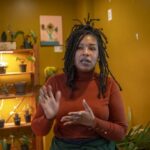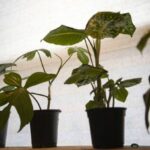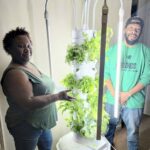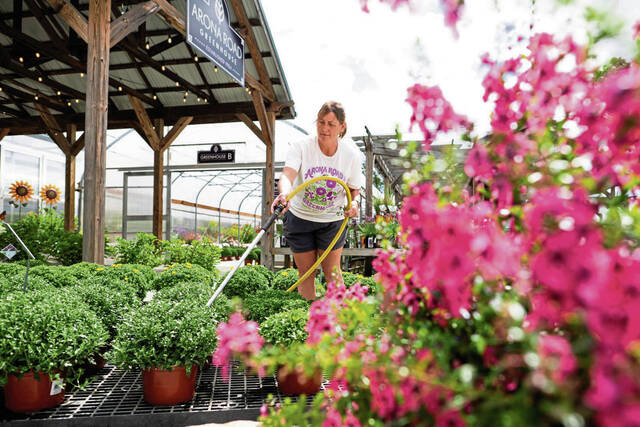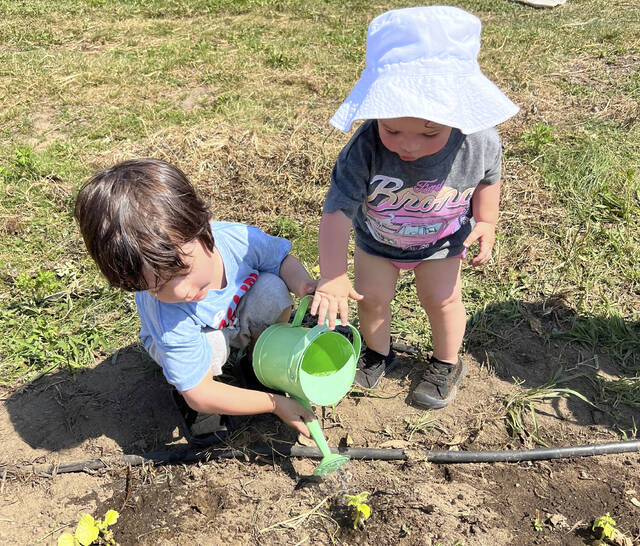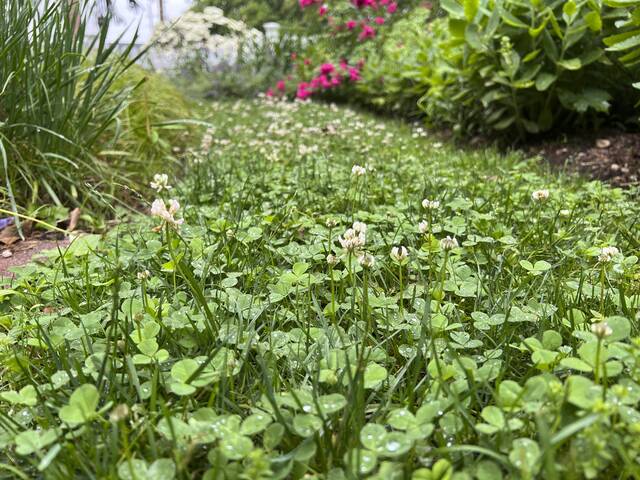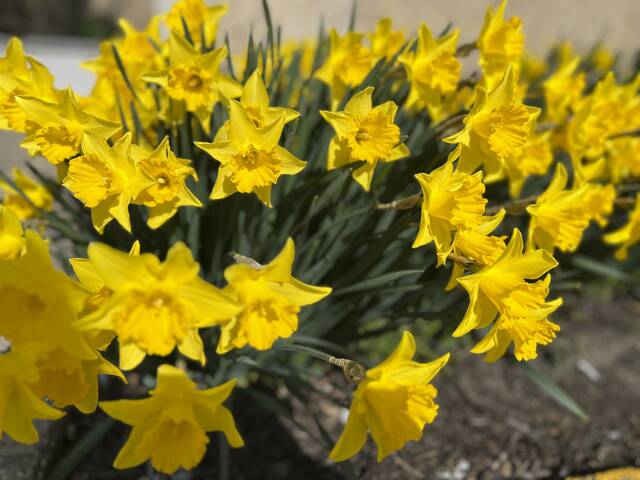Amid winter’s gray skies and unpredictable temperatures, Black communities are reclaiming their narrative through gardening and growing food, a powerful act of resilience that fuels empowerment. Despite sometimes freezing temperatures, they sow seeds of change, heralding a season of growth and autonomy.
Raynise Kelly and TaRay Kelly are owners of Soil Sisters House of Plants. The sisters grew up on Warrington Avenue in Beltzhoover in their grandparents’ home, only a few blocks away from where their storefront is now.
“My grandfather bought the house and my grandmother had two demands — that it had to have a front yard and a backyard, and we were not allowed in either of them,” Raynise Kelly said.
She often would see her grandmother coming from the backyard to the kitchen with a basket in her arm full of tomatoes, peppers, cucumbers and other vegetables. “She would make a lot of pickles and her own hot sauces,” Kelly said.
When Kelly had her daughter, she started to consider how food was being prepared, and how it was entirely different from when she was a child. She wanted her daughter to have access to those same healthy options she had growing up. But she didn’t know how.
“My neighborhood didn’t have a way to educate me,” she said.
She created what she desired.
Kelly, 34, enrolled in Bidwell Training Center’s Horticulture Technology program. She did two seasons working inside a greenhouse and furthered her education with Grow Pittsburgh. In 2020, she and her sister formed Soil Sisters House of Plants and opened their Allentown store in 2022.
They don’t have many in-house plants at the moment, but that will change as the weather gets warmer. Right now, the store stocks ferns, calatheas, cactuses and a few other plants that can withstand the cold and changing temperatures.
For the plants that prefer humidity, they have a humidifier and spray bottle to help ensure they are in an environment to thrive. Their largest plant haul has been a collection of 500 plants in the space. By June, Kelly said, they will have everything.
The walls are a sunshine yellow, a contrast to the winter gray colors that fill the sky. It is a space full of nature and art — which some may consider one in the same.
For January, they have been sourcing seeds from places like Sistah Seeds, a Black-owned seed company in Philadelphia. In February and March, they’ll begin the germination process. Now they are in the process of purchasing four vacant lots that amount to just under 17,000 square feet near their storefront to create a community urban farm just under 1 acre — perfect for a first-generation farmer, Kelly said.
They are still in the negotiation phase with the Urban Redevelopment Authority of Pittsburgh but hope to have things going around March and April.
Their storefront used to be a storage space for a construction company and they revamped much of it, giving it a fresh and sanctuary-like feel.
The purchase of the four vacant lots will allow them to have more events, like the farm-to-table collaboration they had in 2021 where they partnered with RoyallyFit, a community-based holistic health care organization that spoke on the nutritional value of seedlings. Taqueria Acosta prepared a watermelon salad and kale wraps. They also had education about how to care for it and take preventive measures for pests and how to harvest the plant, like kale.
The land will also allow them to bring back their summer camp, Sprout Camp, where youth learn about gardening and growing their own food, which in past years serviced 30 children.
With the land, they also plan to open a farm stand so residents can have access to fresh produce. The nearest grocery store to Beltzhoover, the Shop ’n Save on Virginia Avenue in Mount Washington, is two bus routes away.
Raynise Kelly and her sister want to dismantle the barriers that impede residents from having access to fresh healthy foods.
Growing and gardening also “allows us to heal our relationship with the land, restoring the lost connection,” Kelly said.
“We all know the story of how we as African Americans got here through enslavement, and we know the traumatic story of our relationship with the land and how we had to work the fields to pick cotton,” she said. “But part of that story not talked a lot about is these small gardens. A lot of the enslaved people had them very close to their dwellings so that they could sustain themselves and be resilient enough to make it through.
“We gained knowledge, how we healed ourselves, how we fed ourselves, how we celebrated with food,” she said. “There were so many lessons of gardening that we learned at that time, which created the generations that we have today.”
Mahogany Thaxton, production and sales assistant at Garfield Community Farm, said having power over local food systems is part of Black liberation.
“Our established food systems are not designed to provide communities with easy, affordable access to local, sustainably grown, and culturally relevant food,” Thaxton said. “By growing our own food, whether it’s one tomato plant in a five-gallon bucket, a small backyard garden, community garden plot, or a sprawling farm — we are taking control of our own needs.”
Kelly recommends that people think about harvesting a crop the way they go grocery shopping. In the store, “you pick a tomato when it is bright red and firm,” she said. “That’s when you should pick from your garden as well.”
But tomatoes aren’t in season until the warmer months. For now, during the winter months, the best crops to stick with are root vegetables and leafy greens, Kelly said, like spinach, kale, collards and beets.
The education aspect was important for Kelly because it allowed her to better serve her customers and community, like introducing people to Red Russian kale, which is purple and has a long stem. “A lot of times it is just the unfamiliarity,” she said.
“Me and my sister have been faced with the challenge of educating our community about how to prepare or how to get them thinking in a way that … they are extending their growing season and saving themselves money on buying fresh produce,” Kelly said.
Khadiza Massey of Pittsburgh Policy Food Council and Grounded Strategies said her journey into gardening and growing food started at the Homewood Farmer’s Market. “The people in the community inspired me to do more, even if it is just a community dinner, getting to know people, helping to educate,” she said. “We get to know and grow from each other.”
While Thaxton of Garfield Community Farm is learning more about growing food, she is beginning to understand that the growing season can be all year round — you just have to know what you like, she said.
When it comes to growing in the winter, there are several ways to make it sustainable, according to Thaxton. The first method is preparation during the warm seasons.
“In the spring through fall, folks can grow what they like and preserve their harvests through freezing, canning, and drying to make sauces, pickles, jams, frozen vegetables,” she said.
Vegetables that are good for this type of preservation include cabbages, potatoes, beans, carrots, beets, winter squashes, onions and garlic.
In the winter, it is still possible to grow indoor and outdoor vegetables. Thaxton said that using a sunny indoor spot, “folks can grow herbs, lettuces, microgreens, radishes and green onions.”
Outside with some cover, Thaxton uses clear plastic totes sometimes, piling on top of leaves to create more insulation. Vegetables like kale, collards, spinach, lettuces, radicchio, bok choy, arugula, cabbage, beets and broccoli, can be grown.
Lonnita Hutchinson, a health and wellness advocate in Penn Hills, doesn’t consider herself to have a green thumb, and she didn’t want to do all the weeding — but she’s growing basil, chamomile, cabbage, peppers and mustard greens year-round in her living room using an indoor growing system called Juice Plus+ Tower Garden.
The system is aeroponic, meaning the plants sit in the air in a tall white tower. It uses LED lights, allowing the plants to grow three times faster than in sunlight or natural light, according to Hutchinson. The tower also is self-watering.
“It definitely works for my family, because in Pittsburgh with colder months, grayer weather and not a lot of sun,” she said, “I can still grow without having to cover up plants.”
Hutchinson’s children come along and pick off whatever they like for salads directly from her living room. Her sister was also able to take some basil and oregano from Hutchinson’s harvest.
She said it’s empowering.
The tower costs between $800 and $1,000 (there are also payment plans), but Hutchinson said it was a cost-effective investment for her family of seven.
“It gets pretty expensive grocery shopping. I really get tired of going to the store and getting the lettuce, and I start uncovering it and much of it is brown,” Hutchinson said. “I call it my crockpot on wheels. You put the seedlings for the plants inside, you let it sprout and then you can transport it into the garden system.
“We wanted to become healthier — my husband has diabetes, I have a 16-year-old with some health issues — it was a family choice,” she said. “Being able to have your own food grown organically is awesome.”
This is another way for our community to grow, Hutchinson said.
For the more traditional ways of growing in the winter, Thaxton recommends transforming a raised bed using old heat-treated pallets into a cold frame by covering it with an old window, and using milk and water jugs as mini-greenhouses for herbs and to jumpstart spring seedlings, she said.
Thaxton recommends planting any outdoor in-ground plants early enough that they are established before the first hard freeze.
“We can build food sovereignty through solutions that are designed by and work for us,” she said.
Kelly said on some of these cold, single-digit snowy days, people might have the most success growing kitchen herbs that they might use daily using 3- to 5-inch pots. But like Thaxton, Kelly also recommends cold frames for growing made with foraged materials “like windows, plywood, that can be put in the ground, wrapped with plastic, or blankets,” she said. “To make sure that the plant is able to photosynthesize, but not impacted by the snow, but some lettuce and kale actually like cold temperatures and it makes it crisper.”
She said sitting a plant under a kitchen light is perfect. But what keeps the herb thriving is harvesting them: “Cutting the herb, that’s what will let the herb know it needs to keep producing.”
“As Black people, gardening and growing can be an outlet of relief. Escaping what we deal with day to day is right outside of our doors,” Kelly said.






